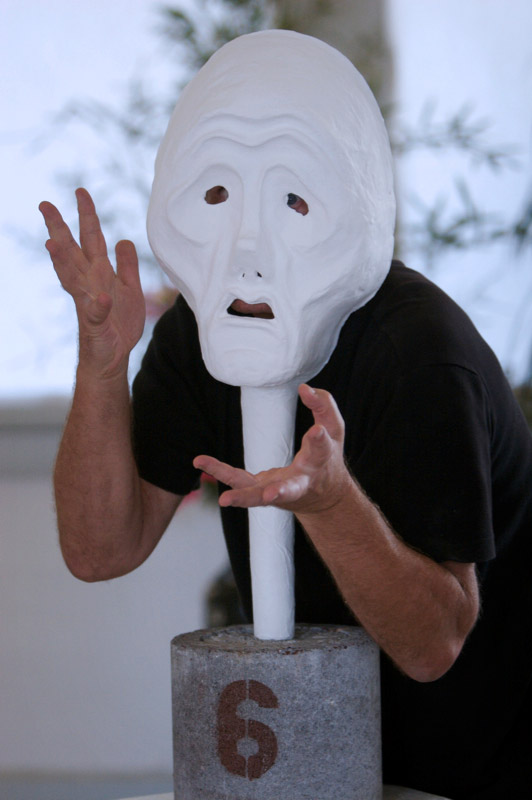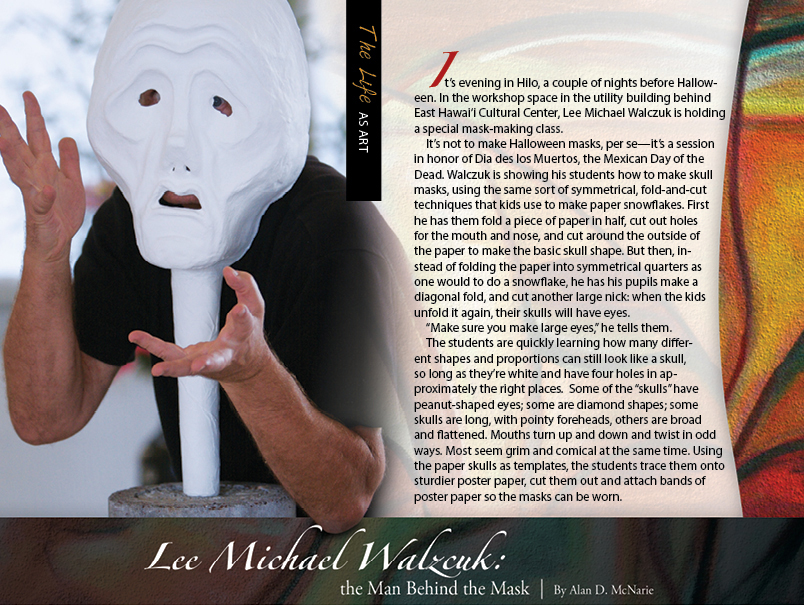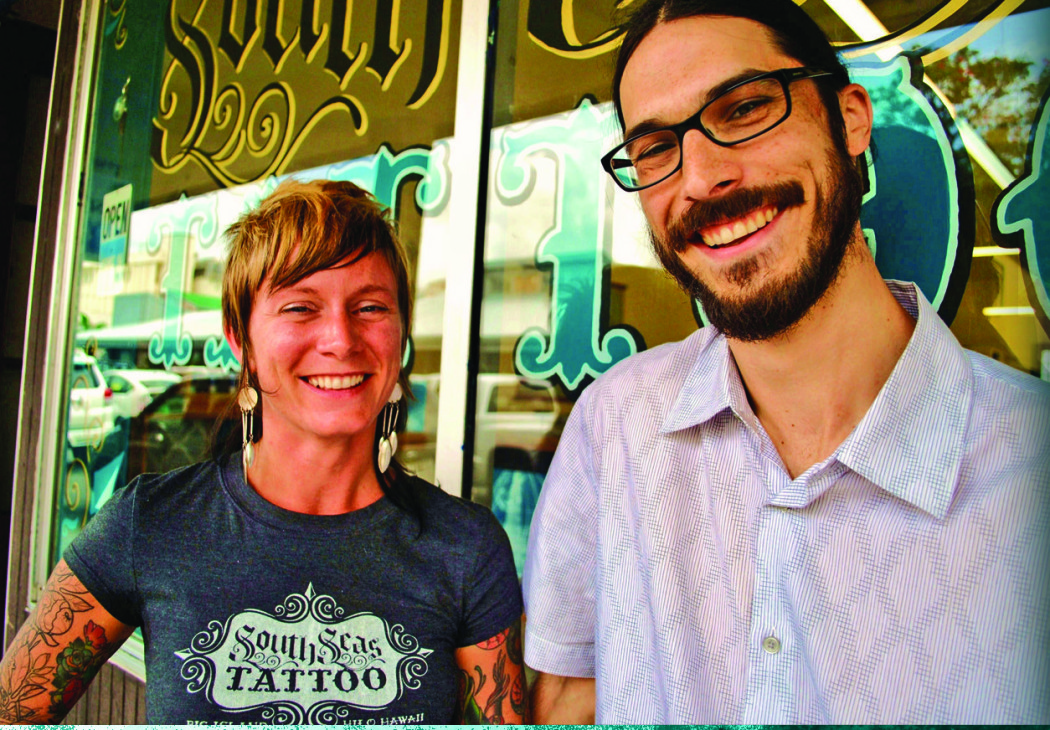
Lee Michael Walczuk: the Man Behind the Mask

By Alan D McNarie
It’s evening in Hilo, a couple of nights before Halloween. In the workshop space in the utility building behind East Hawai‘i Cultural Center, Lee Michael Walczuk is holding a special mask-making class.
It’s not to make Halloween masks, per se—it’s a session in honor of Dia des los Muertos, the Mexican Day of the Dead. Walczuk is showing his students how to make skull masks, using the same sort of symmetrical, fold-and-cut techniques that kids use to make paper snowflakes. First he has them fold a piece of paper in half, cut out holes for the mouth and nose, and cut around the outside of the paper to make the basic skull shape. But then, instead of folding the paper into symmetrical quarters as one would to do a snowflake, he has his pupils make a diagonal fold, and cut another large nick: when the kids unfold it again, their skulls will have eyes.
“Make sure you make large eyes,” he tells them.
The students are quickly learning how many different shapes and proportions can still look like a skull, so long as they’re white and have four holes in approximately the right places. Some of the “skulls” have peanut-shaped eyes; some are diamond shapes; some skulls are long, with pointy foreheads, others are broad and flattened. Mouths turn up and down and twist in odd ways. Most seem grim and comical at the same time. Using the paper skulls as templates, the students trace them onto sturdier poster paper, cut them out and attach bands of poster paper so the masks can be worn.
“The more time you spend, the better they’ll be,” Walzcuk (pronounced WALL-chuck) reminds them, as he moves from student to student. He’s tall, mature looking, with close-cropped gray hair and somewhat melancholic eyes, but his body exudes the energy of a man who’s doing something he loves.
Walczuk is capable of far more complex art than paper skulls. He’s a master mask-maker and puppeteer, who’s studied traditions ranging from European commedia del’arte to Balinese shadow puppetry. He’s designed masks in paper-maché, plaster, wood and leather, bronze, and recycled materials, from hyper-realistic “life masks” molded on living faces to wild grotesques. His puppet creations run a similar gamut, from abstract improvisations made from soy-milk boxes and toilet tubes to Muppet-like cloth puppets to carefully carved marionettes; from simple heads-on-sticks to a magnificent, Asian-inspired dragon-dance costume designed for several people to manipulate. He’s constantly coming up with imaginative new permutations of his art, such as the “mask-puppet,” a mask suspended on a stalk above another, blank mask, which is worn over the face of an actor. Private collectors buy his masks as works of art in themselves, though they’re designed to be part of a larger art: to be worn by humans who transform them and, in turn, are transformed by them.
He loves putting instruments like that into the hands of others, especially children. For years, he’s taught classes in mask- and puppet-making at East Hawai‘i Cultural Center (EHCC). Kids seem to love him, and he loves kids. At the Dia de los Muertos mask workshop, Walzcuk easily held their interest, moving about the room, popping off information about the Day of the Dead, bantering, praising, advising, helping kids pull surprises out of their sheets of paper. He’s a weird blend of erudite scholar, wildly imaginative artist and extroverted actor, seasoned with a large dash of wide-eyed, childlike wonderment that naturally seems to hold kids’ attention.
Walczuk grew up in a Polish-American family in Cleveland, Ohio. Both of his parents were educators, which might explain one part of his personality. But he got the artist and the actor elsewhere.
“I’m the oldest of eight children. That was my task: the babysitter,” he reminisced over the phone, a couple of weeks after the Dia de los Muertos class. “My sister and I started in kindergarten and first grade, taking tap dancing and acting classes.”
Some of his fond, early memories are of a settlement house that served the Polish-American families in his neighborhood. Settlement houses, once common in urban areas, tried to supply uprooted families with the sort of social support network that rural villages once provided. At the Cleveland settlement house, Walzcuk recalls, “The violin was playing, the piano was playing, somebody was singing. So I was brought up with the attitude that the arts were a part of life. I feel that way about Hilo. That’s why I’ve based myself for the last four years at East Hawai‘i Cultural Center. Tonight, while I was teaching my puppetry class, there was classical piano music in the background. They were giving a concert in the black-box theater upstairs. It’s in that spirit—what we have.”
While attending high school, he got seriously involved in acting and trained at the Cleveland Play House. He went to UCLA and played on the basketball team, until an accident altered his
career plans.
“I was injured rather severely, and they gave me a rather horrible therapy,” he remembers. “I started taking dance classes, and I met a Native American who was a dance therapist….” Acting and dance led to mime, puppetry and mask-making. Walzcuk eventually packed up 27 masks and went to spend seven years in Europe, where he acted in several movies and worked as a “busker,” or street artist.
“People would put money and bananas and bread in the hat, so I learned that you could make a living as an artist,” he recalls. “I learned confidence in the street as an artist, as a performer and as a human being.”
He studied Japanese mask-making and puppetry traditions—“I have a great relationship with [traditional mask makers in] Awaji, which is a little island just off of Kobe,” he notes—and Balinese shadow puppetry. He’s taught in Poland and the Philippines. His house in the Kurtistown area, which he shares with his wife, photographer Renata Walzcuk, is crammed with not only his own masks and puppets, but with exemplars of mask and puppetry traditions from around the world.
All of that knowledge now pours into his classes.
“We’ve been doing the shadow puppets,” he says. “We’ve been doing the string puppets, we’ve been doing the Muppet-style hand puppets….”
And all that training in all those different art forms can make a conversation with Walzcuk a fascinating, and sometimes disconcerting, experience. You never know what subject he’ll veer off into, or when he’ll slip into a role or switch into mime mode or project his personality into a nearby mask, or when he’ll pick up a stick or a box and suddenly bring it to life as a puppet. But that range of talents on display is also an example to his students of the diversity of possibility.
“There are multi-talented children,” he believes, “but they lose their talents because [they’re told] ‘You have to do that,’ or ‘You have to use just one [talent].’
All of those other arts led him into cinematography, which he also teaches at EHCC. He holds an MFA in Theatre, Film and Animation from UCLA.
“Basically, my work is called animation theatre: the idea that puppetry and theater and cartoon and film—they’re all entwined…,” he says. “The birth of the cinema came out of animation discoveries, the invention of film, the discovery of the magical lantern, which was really the slide projector….”
His cinema class is winding up a unit on documentaries (One of his students is flying off to Las Vegas to do a documentary short about Vegas street people) and is going to tackle film noir next—or, at least, a tongue-in-cheek, Hilo-style version thereof.
“We’re looking for non-experienced actors to get involved, because it’s going to be a fun kind of a thing. People who sold sugar cane from the field, or there were some bananas missing from the trees….” he says.
He doesn’t make a lot of money on his classes; a Maui non-profit called Ebb and Flow Arts subsidizes some of his expenses to keep the classes going. In addition to the EHCC classes, which he notes are actually open to “children of all ages”—he encourages parents to come with their kids—he works with Hilo’s Adult Care Center and with the Abled Hawai‘i Arts Festival.
Eventually, he hopes to open a small theater in Hilo that gives performances every Saturday. But meanwhile, he’s helping the flowers of imagination to open and nourish people’s lives, one person at a time.
“If you can create one image, then you’re beginning to use your imagination, because within imagination is that one word: image,” he believes. “If we can help you to find one image, that’s all we need. From that one image, we can then go into an imaginative world.”
Ongoing workshops with Lee Michael Walczuk:
- Cinema Workshop, Wednesdays 5:30-7:30pm East Hawai‘i Cultural Center. Classes meet in the Annex or Theater. $10 per class. All ages welcome.
- Marionette Workshop, Thursdays 5:30-7:30pm Classes meet in the Annex. $10. All ages welcome.
To register, or for more information call Brenda at 961.5711 or 935.9085 or email. Advance registration and payment is required for all workshops and classes.
Photos by Renata Walczuk


